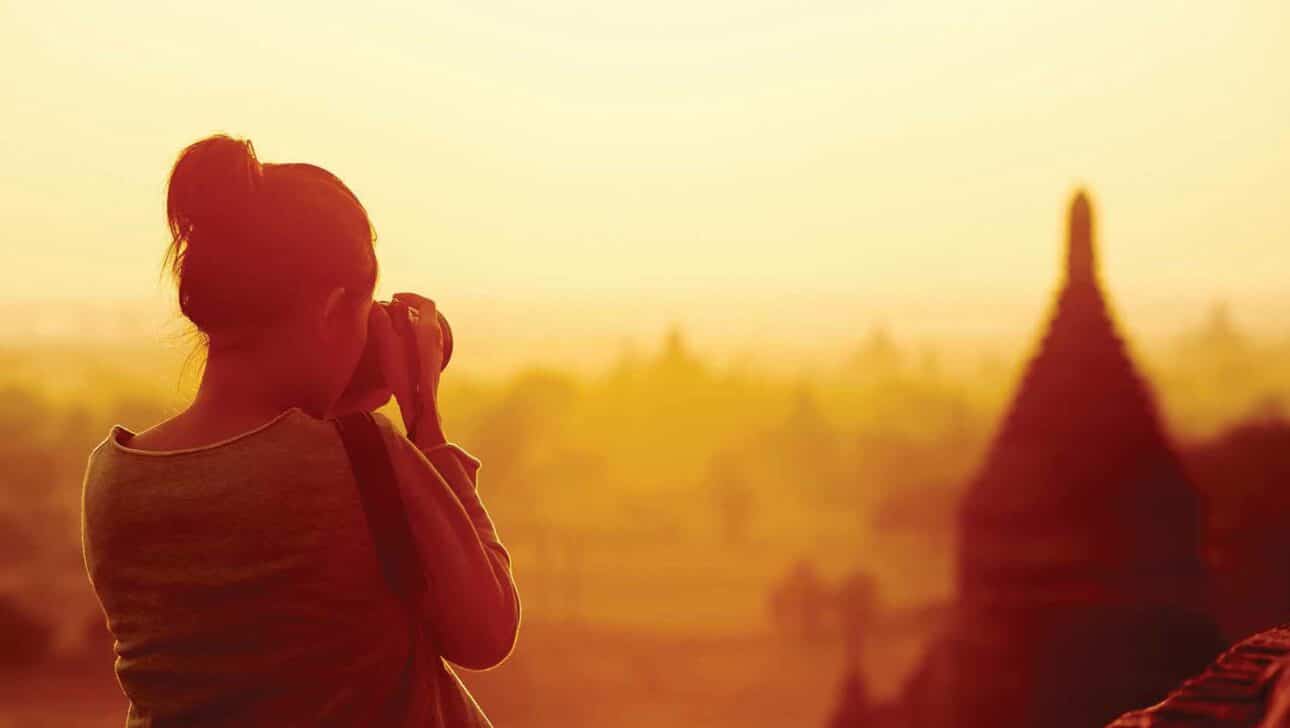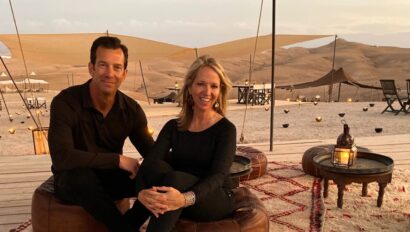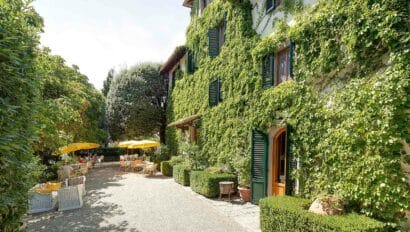Sure, we feel obliged to shoot pictures. But could photography be a distraction from the full pleasure of travel?
Here’s a modest proposal: Next trip, leave the camera at home.
Sound scary?
Travelers have some funny notions about shooting pictures on the road. After all, if we don’t come back with pictures, we weren’t really there, right? We’re convinced that photographing our travels is a way of rendering them permanent. Life is fleeting enough; vacations more so. But as long as we can look at our pictures, our journeys live on.
On one level, that’s all true. When we flip through or click through our photos, when we share them with friends, we conjure up visual cues that bring back pleasant memories and assure us that we were indeed there. But is it possible that our devotion to our cameras can actually hinder the very experience we came to have? After all, traveling is more than a series of visuals.
A few years ago, I experimented with the concept of camera-free travel. I admit I stumbled upon this notion inadvertently, having arrived at my destination with a dead battery and no charger. Oops. I went through a litany of self-condemnations and suffered a feeling of dread, as if all ensuing experiences would be taken away from me for lack of photographic evidence.
It didn’t work out that way. In fact, I quickly felt a sense of liberation, and not just from the weight of my camera and lenses. I was no longer constantly asking myself, Would this make a good photo? Would that make a good photo? Should I move, should I run up ahead, should I ask this man if it’s okay to take his picture? And why, oh why, is the sun where it is when it would be so much better over there?
I happened to be in Chiapas (on a magazine assignment, not a Classic Journeys trip; I’m a travel writer). I found myself deeply fascinated with details big and small—the way the jungle air felt on my skin, the evocations conjured by spicy aromas, the treetop conversations of howler monkeys. I mused on the meaning of glyphs carved in stone. I didn’t have to photograph fried ants to taste and remember them. I sat and stared at some astounding Mayan ceiling murals. With a camera, I’d have been content to shoot a few pictures of them and move on. Instead I let their stories and colors wash over me as I paid close attention to my guide’s interpretations.
When I met locals, I engaged them. I didn’t put a camera between us. And when I saw other travelers busily snapping photos of those same people, I could sense the distancing and even the condescension taking place in the implied statement: “Hey, locals, we think you’re charming and want to take souvenir photos of you.” But they weren’t interested enough to ask the locals their names.
It’s possible, I thought, that shooting photos had been making me a schizophrenic traveler—one who was having the experience, and another who was documenting it. Suddenly, without my camera, I was feeling more engaged, more present. Was I onto something? Should I make my separation from the camera permanent?
Just One of Your Senses
I decided to put these thoughts to the Classic Journeys community—travelers, guides, the chief executive—most of whom are committed photographers. Maybe together we could find a way to be fully engaged travelers—but still return home with some nice pictures.
Jan Kentala is a Minnesota-based professional photographer who has traveled on Classic Journeys’ Taste of Tuscany culinary tour. She fully admits that, in photography, “If you have your camera to your eye all the time, you miss out on other things. You’re using just one of your senses. If the camera is down, I feel more of my senses open, more dimensional.”
Jan took a camera to Tuscany, but didn’t feel ruled by it. Instead, she parceled out camera time and noncamera time. She’d say, “Now I’m going to do photography,” and give herself an assignment, such as shooting flowers, or old doors, for an hour or so at a time. For long stretches, she simply put the camera away.
It’s Not About the Gear
Classic Journeys guide Eric Kessler is also a professional photographer, one who shoots constantly (“there’s almost no time I think I shouldn’t be photographing”), yet never feels distanced or disengaged from his travels. “It’s the way I interact,” he says. “It brings me deeper into the experience. I think and view the world very graphically.”
Kessler observes, though, that many of his guests get infatuated with and distracted by their equipment. “They lose their spontaneity, their ability to be here.” His suggestion: Learn your equipment so well that using it becomes second nature. Unlike many camera snobs, Kessler says to let your camera run on autopilot, even if it has all sorts of bells and whistles. “I shoot in Program mode about 70% of the time,” he says, where the camera makes most of the technical decisions.
But Kessler’s mind and his eye are ever alert. He recalls leading a Grand Canyon tour and enjoying a meal with guests in the North Rim dining room at the end of a long day. “I noticed that light had broken through the clouds. I looked out and there was a double rainbow at Bright Angel Point and a shadow hitting the North Rim. It was like a dark line was rising as the sun was setting. I ran outside and started shooting, then just came back in and resumed the conversation.”
Kessler’s caution about gear rings true with Classic Journeys traveler Deannna Sava, who loves nature photography, but left her fancy equipment at home on her recent trip to the Swiss Alps. “I still captured beautiful photos,” she says, even without her customary macro lens, diffuser, tripod, and reflector. She plans to travel light again on her upcoming Tuscany tour: “I realize I can’t use all that when traveling with a group.” But she won’t sacrifice her affinity for shooting. “For me, photography is a contemplative experience. I’m just looking to capture beauty for myself and to share.”
A Classic Journey’s guest shares his camera with the excited and intrigued village children in Vietnam.
Listen to Your Guide
To my point about a camera becoming a barrier, Classic Journeys president and founder Edward Piegza points out that it can also be an opener, an icebreaker. On a Vietnam trip, he engaged schoolchildren at a village school who agreed to be photographed, then clustered enthusiastically around Piegza to view every shot with delight. The same thing happened with a group of elderly village ladies in Danang.
So when is it all right to photograph local people? How do we know they won’t feel we’re robbing their soul, or just plain insulting them? Listen to your guide, is Piegza’s advice. “We’re always in the company of expert local guides on Classic Journeys trips,” Piegza says. “They know the villages. They can speak in the local dialect and ask if it’s okay to take a photograph.”
On a trip in Peru, a guest neglected to consult his Classic Journeys guide, Franklin Vargas, and managed to upset an older woman in Cusco’s San Pedro Market. “Most of the vendors are used to seeing visitors,” says Vargas. “But this senior lady did not like being photographed. We had to delete that picture in front of her.”
Guides also know the landscape of their regions and can steer guests to supreme vantages so that they don’t feel obligated to shoot constantly. “We often want to document everything,” says Piegza, “but our guides will tell us when there’s an awesome viewpoint coming up as we approach the Sun Gate at Machu Picchu . . . or they know that just around a bend in the Ourika Valley in Morocco is a village with super friendly kids.”
As for shooting everything, another Classic Journeys guide, Luciano Niccolai, has learned that the first shot of anything is usually the best. “The first one is the spontaneous one,” explains the veteran Italy guide. When everyone insists on taking many shots of every subject, it can be taxing (and slowing) to the entire group. But on a recent trip to the Cinque Terre, Niccolai hit on an alternative: designating a trip photographer—a skilled ones with good gear—to do the bulk of the shooting. “I found that having someone appointed by the group to take photos can make it easier. After the trip, they make a CD and send it to everyone.” Guests still take their personal shots (“stand over there, Honey, by the edge of the cliff”), but the group feels lighter and freer when someone else handles the artsy stuff. It’s not a Classic Journeys policy; just an option on Niccolai’s trips.
Still Shooting, But . . .
I haven’t thrown out my camera gear. I did go camera-free a couple more times, and none of those trips was magically snatched from me for lack of photographic evidence. Never once did I hear complaints from friends back home deprived of a post-trip photo show. Those trips are as vivid in my memory as the many trips I’ve photographed.
I’m back to carrying a camera on my travels, but I’m conscious of subsuming the role of photography. I often ditch the SLR and go with a point-and-shoot. I snatch shots as a form of note taking, but I don’t worry about missing any. I’m clear about why I travel. I travel to have experiences, to learn, to immerse myself in the fullness of a destination and its culture. For that I need all my senses alert and operating. To obsess about photography is, for me, a distraction from the full pleasure of travel. And I didn’t really know that until I showed up on a trip with a dead camera battery.
Bob Howells is the 2009 Lowell Thomas Travel Journalist of the Year Silver Award winner and has earned four National Magazine Awards for General Excellence at Outside and National Geographic Adventure. Over more than three decades Bob has written more than 1,000 articles in national magazines, four books, television, and radio.




